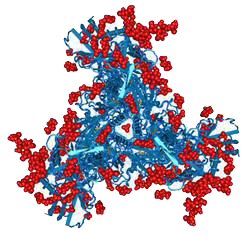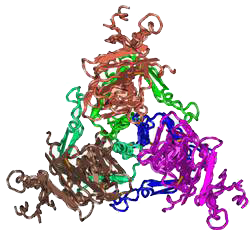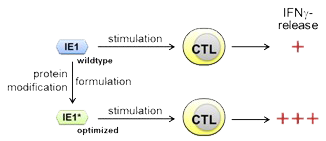Molecular Microbiology (Virology)
Institute of Medical Microbiology and Hygiene
University Regensburg
Funding: Bill & Melinda Gates Foundation
Attenuated viral vectors used as delivery system for heterologous immunogens are supposed to be more potent inductors of immune responses than inactivated viruses or purified proteins. In collaboration with Sanofi Pasteur we are developing novel live-attenuated Flavivirus-based vectors for the delivery of HIV immunogens based on Sanofi’s RepliVax® platform. For this, we are designing specially adapted HIV-derived immunogens with improved expression and stability. The novel vaccine candidates will subsequently be characterized for the induction of broad T- and B-cell responses. In addition, to further improve the vaccine’s potency, strategies will be developed allowing specific targeting of immunogens to dendritic cells (DCs) via antibodies directed against DC cell surface molecules.
Funding: Eurostars
HPV infections causes more than 250 thousand deaths per year with more than 85 % of these occurring in middle- and low-income countries. The availably prophylactic vaccines are not suitable to eliminate established infections and thus prevent cancers that come as a consequence of the limited acceptance of vaccinations.
The THERIN partners therefore aim at developing a therapeutic vaccination strategy for the eradication of already existing HPV infections. The vaccine candidates shall be tested in non-human primate models for immunogenicity and efficacy, so that a finally a human candidate ready to enter clinical development will be available.
The Wagner lab contribution to the project encompasses the antigen design (protein and gene design), the generation of DNA- and MVA-vaccine-vectors (involving subcontracting partner ProBioGen), and their ex vivo characterization. Project partner Sirion-Biotech will contribute adenovirus vectors carrying the same antigens. In cooperation with Prof. Peter Holst (University of Copenhagen), the pre-clinical studies in mice and non-human primates (in cooperation with the Bogor Agricultural University) will be perfomed.

Funding: H.W. & J. Hector Stiftung
The development of an effective HIV vaccine represents the most promising approach to end the AIDS pandemic, and this will almost certainly require the generation of long-lived antibody responses. Humoral long-term immune responses are provided by plasma cells and memory B cells, both of which arise from the germinal center reaction within the lymphoid follicles. This process is critically dependent on follicular helper T cells (Tfh) that provide signals markedly impacting the respective antibody response function, subclasses as well as longevity of the humoral response.
In this project, we plan to determine the impact of the glycan shield of HIV’s envelope protein (Env) on the fidelity of Tfh-mediated processes in the context of different HIV vaccination strategies. We hypothesize that this large glycan shield is a major factor mitigating and modulating the development of memory induction for humoral immune responses. A large fraction of the surface of Env is shielded by N-linked glycans and immune responses against carbohydrates are generally poor and not long-lived. Indeed, it has been demonstrated that carbohydrate antigens can activate a T cell-independent pathway that involves extrafollicular B cells by cross-linking BCRs. In the absence of CD4 T cell responses, however, longevity of B cell responses is only poorly induced. To test this hypothesis we will genetically engineer Env vectors with different levels of glycosylation by modification of N-glycan binding regions. We will then test the capacity to induce humoral and cellular immune responses in in vitro models and in mice, and will assess their longevity.
Crystal structure of the trimeric HIV envelope protein (blue), highlighting the position of glycosylation sites (red), viewed from top (drawn from PDB 4TVP)

Funding: Innovate UK
Zoonotic transmission of highly virulent filoviruses can rapidly lead to public health crises, as emphasized by the recent West African Ebola outbreak in 2014/2015 that killed more than 10000 people. An important countermeasure in such cases would be an efficacious vaccine, but the time scales for vaccine development starting from isolation of a prototypic outbreak virus to clinical safety trials is overly long in such situations.
Thus, the EVAC team is setting up a new vaccine technology platform to generate vaccine prototypes that are designed for elicitation of broadly protective responses towards diverse filoviruses including possibly new strains. The development is based on integrating sequence data of outbreak pathogens, broadly neutralising monoclonal antibody reactivity profiles, computational modelling methodologies, gene synthesis technology and in vivo immune selection and vaccine efficacy readouts.
The Wagner lab contribution to the project encompasses the gene design and synthesis of the novel prototype antigens, generation of vaccine vectors and production of DNA vaccines for immunogenicity and efficacy tests in animal models.
Crystal structure of the Ebola virus glycoprotein viewed from top (drawn from pdb 5KEL)

Funding: Innovate UK
Outbreaks of haemorrhagic fever viruses occur again and again especially in West and Central Africa, with often rapidly increasing case numbers and significant morbidity and mortality (e.g. West African Ebola outbreak in 2014/2015). Of special concern are the filoviruses Ebola virus (EBOV) and Marburg virus (MARV), and the arenavirus Lassa virus (LASV).
A single vaccine protecting from these three viruses would be highly desirable not only for outbreak responses but – given economically viable production – also for prevention in regions where these viruses are endemic. As poxvirus vaccines proved to be very efficient regarding manufacturability, distribution, administration and efficacy in the smallpox eradication campaign, the Tri-LEMvac consortium is dedicated to developing a heterologous vaccine candidate based on the licensed Modified Vaccinia Ankara (MVA) smallpox vaccine as delivery vector for antigens from LASV, EBOV, and MARV (“Tri-LEM”).
Within the current project, the Tri-LEMvac team will work together to generate the vaccine prototype and test it in preclinical models for immunogenicity and efficacy in Ebola- and Lassa-challenge-models.
The Wagner lab contribution to the project encompasses gene design and synthesis of the prototype antigens, as well as the generation and characterization of the MVA vaccine vectors.
Further analyses and the preclinical evaluation will be done in cooperation with Prof. Jonathan Heeney (project coordinator) and Simon Frost (University of Cambridge), Miles Carroll (Public Health England), and Edward Wright (University of Sussex).

Funding: European Union – Seventh Framework Program
The Seventh Framework Program funded SYNPEPTIDE project (lead by Prof. Dr. Sven Panke, ETH Zürich) joins multiple European scientific groups to use synthetic biology for the design and production of novel peptide antibiotics.
In the preceding SYNMOD project, molecular modules have been selected and recombined to obtain enhanced and new functions and a technology for high throughput screening for antimicrobial activity has been established. The SYNPEPTIDE project will now optimize previously established techniques and include additional features like the site specific co-translational incorporation of non-canonical amino acids as well as additional posttranslational modification machineries to obtain a highly diversified number of synthetic and redesigned (l)antibiotic peptides.
Further information: click here

Funding: European Commission (FP7)
Databases containing full-length sequences, experimentally identified T cell epitopes and protein structures from various HIV-1 isolates are readily available. Bioinformatic tools will be developed within this network to benefit from this vast amount of data in order to build novel GagPol variants representing universal HIV immunogens. For this, the proteins will be enriched with CD4- and CD8-epitopes epitopes from different clades while ensuring structural and functional preservation. Epitopes are selected preferentially if they are highly conserved among various HIV clades, known or predicted to be presented by frequent HLA haplotypes, or are observed in long-term nonprogressors. Furthermore a cellular display technology will be applied to screen libraries of native envelope derivatives in a membrane bound form against monoclonal neutralizing antibodies (Nabs) (compare VDAC project). This strategy will be adapted to screen envelope libraries based on CD4-independent envelopes, which have been shown to induce unusually high levels of bNabs (Zhang and Dimitrov, 2007). The optimized B- and T-cell immunogens formulated as protein, DNA, viral vectors or virus-like particles will finally be evaluated in transcutaneous immunizations.
Funding: Bayerische Forschungsstiftung
The ForBIMed Research Cluster (led by Prof. Dr. Ralf Wagner) funded by the Bavarian Research Foundation focuses on the development of new biomarkers to improve diagnosis, therapy and prevention of infectious diseases.
Within this cluster we will – together with our partner – Lophius Biosciences GmbH – concentrate our efforts on the development and improvement of novel technologies to monitor pathogen specific T-cell responses.
Recombinantly produced proteins are frequently used to stimulate T-cell responses either in diagnostic (e.g. detection of virus-specific T-cells) or immunoprophylaxis settings (i.e. as a vaccine). The pathogen-derived proteins, however, differ in their stimulatory capacity due to diverse inherent protein properties. The immediate early 1 (IE1) protein of cytomegalovirus (CMV) would be an interesting candidate for the above named applications due to its high and early expression during the viral replication cycle, however it lacks potent stimulatory activity. Therefore, our aim in this project is to modify and formulate the protein in a manner to increase the T-cell-activating properties. The resulting IE1-variants/formulations will be tested in suitable ex vivo and in vivo models for their potential to re-stimulate or prime naïve IE1-specific T-cells.
Further information: ForBIMed – Biomarker in der Infektionsmedizin

Funding: Bill & Melinda Gates Foundation
HI-viral particles are ideal vehicles to present combinatorial libraries of gp41 and gp140 derivatives in a membrane environment. Thus, we are generating lentiviral libraries displaying many variants of stable trimeric derivatives generated by various ‘molecular evolution’ approaches. Iterative rounds of panning with available and new NMabs at increasing stringency will select high affinity binders. Selected and re-amplified particles displaying Env variants will be further assayed for (i) affinity to different NMabs (Biacore), (ii) trimerization state and (iii) stability. Selected Env antigens will be produced as immunogens as VLPs, proteoliposomes or recombinant proteins. The correlation between binding affinity and breadth of neutralization (antibody responses in rabbits) will be determined.
In addition a FACS-based screening system for epitope identification of anti-Env-antibodies will be developed. High throughput FACS analysis of an Env-library comprising individual alanine mutations at any position will identify critical amino acids for the binding of antibodies of interest.
Funding: Bill & Melinda Gates Foundation
Attenuated viruses are promising candidates as delivery system for HIV immunogens. Especially poxviruses are of interest due to their good immunological properties, like the avian poxvirus ALVAC used in the RV144 phase III Thai-Trial where a small protective effect was observed for the first time.
In collaboration with the Centre Hospitalier Universitaire Vaudois (CHUV, Lausanne, Switzerland) we are designing a panel of New York Vaccinia Virus (NYVAC)-based HIV vaccine candidates with the aim to increase their potency in eliciting HIV-specific T cell responses. For this, transgene expression is optimized and the ratio of GagPolNef versus Env expression is modulated in order to balance the responses. Finally, the novel poxvirus-vectors are evaluated for increased immunogenicity (CTL responses) in small animal (mouse) models. The best-in-class immunogens will subsequently be assessed in non human primates and compared to other vaccination approaches (protein, DNA).
Funding: Hector foundation
Long term non progressors (LTNPs) are HIV-positive patients who develop AIDS after much longer times. In some cases, this is due mechanistically due to potent CTL responses (compare ForProtect above). To develop novel vaccine candidates potentially giving rise to CTL responses with increased breadth, epitope-enriched Gag, Pol and Nef immunogens are being designed using in silico algorithms. In parallel, different viral vector systems (poxvirus (NYVAC), adenovirus, equine herpesvirus) are evaluated immunologically for their capacity to induce direct- and cross-presentation in human dendritic cells ex vivo. Finally, the best-in-class viral vectors will be combined with the novel immunogens and T cell profiles of (i) CTLs restimulated by infected human DCs ex vivo and (ii) of in vivo primed T cells from mice will be determined and assessed against T cell profiles from LTNPs.
Funding: Bavarian Research Foundation
The protective phenotype of some HIV-positive long-term-non-progressors is associated with CTL responses against peptides presented on certain HLA alleles. As approaches to induce such responses by vaccination have failed so far, we want to generate epitope-enriched variants of the HIV Gag protein to achieve a broader immune response. For this, a computer-algorithm will be developed which (i) classifies CD8 T-cell epitopes previously identified in patients according to their immunological properties and (ii) incorporates a maximal number into Gag, (iii) ensuring structural and functional preservation. The performance of the algorithm will be validated experimentally by biochemical characterization of the epitope-enriched immunogen candidates. Finally, functional epitope-enriched Gag variants will be immunologically characterized in human ex vivo model systems.
Further information: click here
Funding: European Science Foundation
The ESF-funded SYNMOD project (lead by Prof. O. Kuipers, University of Groningen, NL) joins different European scientific groups to use synthetic biology for the design and production of novel antibiotic molecules from the group of lantibiotics. For this, more than 30 sub-molecular modules have been selected and will be recombined to obtain new functions. As there is so far no reliable molecular shuffling techniques available to combine such short DNA fragments without using conserved sequences between them, we established a new gene synthesis protocol for the seamless combinatorial synthesis of several libraries. To support the establishment of new lantibiotic production pathways, we also set up a collection of mutagenized expression elements, specifically promoters, terminators, and intergenic regions.
Funding: Federal Ministry for Education and Research (BMBF)
As people get older so does the immune system. This phenomenon of ‘immunosenescence’ leads to an increased susceptibility to infection and a lower vaccination success, for example against influenza. The GerontoShield project under the coordination of Prof. Guzmàn (Helmholtz Centre for Infection Research) aims to generate mathematical models of immune pathways from various data sources. To this end our group contributes data from murine dendritic cells stimulated with various adjuvants, which are to be analyzed for their surface markers, cytokine production and gene expression profiles.
Funding: International AIDS Vaccine Initiative (Innovation Grant)
The main objective of this project is the identification and selection of HIV envelope variants with high trimer stability and enhanced binding affinity of bNMABs such as PG9 and PG16. Therefore, in vitro display technologies developed in our group will be used to screen DNA libraries encoding HIV envelope protein variants. Selected candidates will be cloned in mammalian expression vectors and used in a transient expression system. Recombinant Envelope proteins will be provided to cooperation partners for biophysical characterization including analysis of PG9, PG16, b12 and CD4 binding by SPR and stability measurements using the thermofluor assay or circular dichroism. Selected candidates that show higher stability than wild type and better binding to mAbs PG9 and /or PG16, b12 and CD4 will be selected for scale up production and subsequent immunization studies.